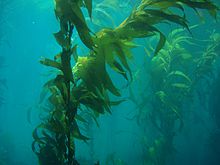
In ecology, the foundation species are species that have a strong role in structuring a community. A foundation species can occupy any trophic level in a food web (i.e., they can be primary producers, herbivores or predators). The term was coined by Paul K. Dayton in 1972,[2] who applied it to certain members of marine invertebrate and algae communities. It was clear from studies in several locations that there were a small handful of species whose activities had a disproportionate effect on the rest of the marine community and they were therefore key to the resilience of the community. Dayton’s view was that focusing on foundation species would allow for a simplified approach to more rapidly understand how a community as a whole would react to disturbances, such as pollution, instead of attempting the extremely difficult task of tracking the responses of all community members simultaneously. The term has since been applied to a range of organisms in ecosystems around the world, in both aquatic and terrestrial environments. Aaron Ellison et al. introduced the term to terrestrial ecology by applying the term foundation species to tree species that define and structure certain forest ecosystems through their influences on associated organisms and modulation of ecosystem processes.[3]
- ^ Byrnes, J. E.; Reed, D. C.; Cardinale, B. J.; Cavanaugh, K. C.; Holbrook, S. J.; Schmitt, R. J. (2011). "Climate-driven increases in storm frequency simplify kelp forest food webs". Global Change Biology. 17 (8): 2513–2524. Bibcode:2011GCBio..17.2513B. doi:10.1111/j.1365-2486.2011.02409.x. hdl:2027.42/86837. S2CID 548840.
- ^ Dayton, P. K. 1972. Toward an understanding of community resilience and the potential effects of enrichments to the benthos at McMurdo Sound, Antarctica. pp. 81–96 in Proceedings of the Colloquium on Conservation Problems Allen Press, Lawrence, Kansas.
- ^ Ellison, Aaron M.; Bank, Michael S.; Clinton, Barton D.; Colburn, Elizabeth A.; Elliott, Katherine; Ford, Chelcy R.; Foster, David R.; Kloeppel, Brian D.; Knoepp, Jennifer D. (2005). "Loss of foundation species: Consequences for the structure and dynamics of forested ecosystems". Frontiers in Ecology and the Environment. 3 (9): 479. doi:10.1890/1540-9295(2005)003[0479:LOFSCF]2.0.CO;2. hdl:11603/29165.